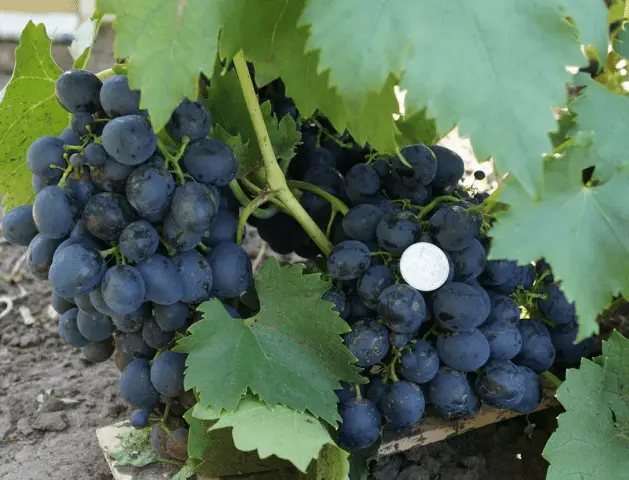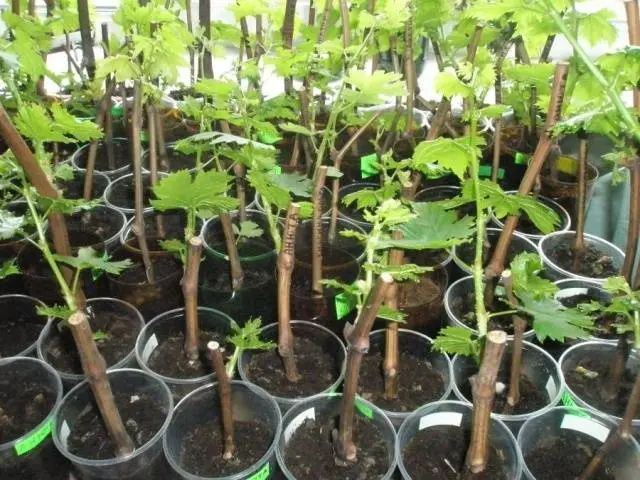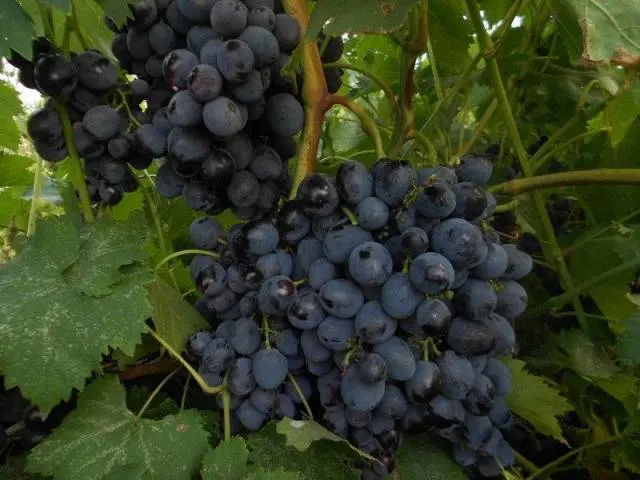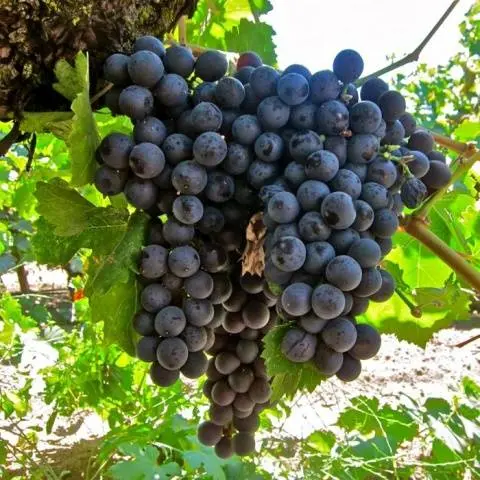Contents
Sphinx grapes were obtained by Ukrainian breeder V.V. Zagorulko. It was bred by crossing the Strashensky variety with dark berries and the white nutmeg variety Timur. The variety is characterized by earlier ripening and harmonious taste of berries. Grapes are resistant to diseases, not subject to spring cold snaps, but require additional shelter for the winter.
Characteristic of the variety
Description of the variety and photo of Sphinx grapes:
- ultra early maturation;
- the period from bud swelling to harvest takes 100-105 days;
- vigorous plants;
- large dissected leaves;
- early and full ripening of the vine;
- flowering late enough to avoid spring frosts;
- clusters of cylindrical shape;
- the average weight of bunches is from 0,5 to 0,7 kg;
- frost resistance up to -23 °С.
Sphinx berries have a number of features:
- dark blue color;
- large size (length about 30 mm);
- weight from 8 to 10 g;
- the shape is round or slightly elongated;
- pronounced aroma;
- sweet taste;
- firm juicy flesh.
Clusters of Sphinx grapes hang on the bushes for a long time without loss of commercial and taste qualities. In cold and rainy summers, peas are observed and the concentration of sugar in fruits decreases.
The maturation of the Sphinx variety depends on the region. Harvesting usually begins in early to mid-August. Berries are used fresh. Transportability is rated at an average level.

Planting of grapes
Sphinx grapes are planted in prepared areas. The taste and yield of the crop depends on the right choice of a place for growing. For planting take healthy seedlings from proven manufacturers. Work is carried out in the spring or autumn. When planting, fertilizers are applied to the soil.
Preparatory stage
Sphinx grapes are grown in well-lit areas. For culture, choose a place on the south, west or southwest side. The permissible distance from fruit trees and shrubs is from 5 m. Trees not only create shade, but also take away a significant part of the nutrients.
When planting on the slopes, the grapes are placed in its central part. Lowlands, where plants are subject to frost and moisture, are not suitable for growing the Sphinx variety.
Grapes prefer sandy soil or loam. The location of groundwater is at a depth of more than 2 m. The root system of the Sphinx variety is powerful enough to receive moisture from the soil. Coarse river sand is introduced into heavy soil. Peat and humus will help improve the composition of sandy soil.
For planting, one-year-old seedlings of the Sphinx variety with a developed root system are chosen. Overdried plants with falling eyes do not take root well.
Order of work
Grapes are planted in planting holes. Preparation begins 3-4 weeks before planting. Be sure to prepare fertilizers in the required amount.

The order of planting grapes Sphinx:
- At the selected site, a hole is dug with a diameter of 0,8 m and a depth of 0,6 m.
- A drainage layer is poured at the bottom with a thickness. Expanded clay, ground brick or crushed stone is suitable for it.
- A pipe for irrigation made of plastic or metal is vertically dug into the pit. The diameter of the pipe is about 5 cm. The pipe should protrude 20 cm above the ground.
- The pit is covered with earth, where 0,2 kg of potassium sulfate and 0,4 kg of superphosphate are delivered. An alternative to minerals is compost (2 buckets) and wood ash (3 l).
- When the earth settles, a small hill of fertile soil is poured into the pit.
- The seedling of the Sphinx variety is cut off, leaving 3-4 buds. The root system is slightly shortened.
- The roots of the plant are covered with soil, which is slightly tamped.
- Grapes are watered with 5 liters of water.
According to reviews, Sphinx grapes quickly take root and form a powerful root system. After planting, the Sphinx variety is cared for by watering. During the month, moisture is applied every week, in the future – with an interval of 14 days.
Variety care
Sphinx grapes need constant watering, which includes fertilizing, pruning, protection from diseases and pests. In cold regions, bushes cover for the winter.
Watering
Young plants aged no more than 3 years need regular watering. They are watered through a drainage pipe according to a certain pattern:
- in early spring after removing the shelter;
- when forming buds;
- after the end of flowering.
The water consumption for each bush of the Sphinx variety is 4 liters. Moisture is pre-defended in barrels, where it should warm up in the sun or in a greenhouse. Watering the grapes is combined with top dressing. 200 g of wood ash is added to the water.
Mature grapes are not watered during the season. Moisture must be applied in the fall before shelter. Podzimny watering prevents the culture from freezing.
Feeding
When using fertilizers for the planting pit, the plants are provided with useful substances for 3-4 years. In the future, Sphinx grapes are regularly fed with organic matter or mineral components.
For the first top dressing, which is carried out after the shelter is removed from the grapes, nitrogen fertilizer is prepared. From organic substances, chicken manure or slurry is used. Grapes respond positively to the introduction of 30 g of ammonium nitrate into the soil.
Before flowering, the treatment is repeated with the addition of 25 g of superphosphate or potassium sulfate. It is better to refuse nitrogen components during flowering and ripening of berries, so as not to provoke excessive growth of green mass.
When the ripening of the berries begins, the grapes are fed with superphosphate (50 g) and potassium sulfate (20 g). Substances are buried in the ground during loosening. In autumn, after harvesting, wood ash is added to the soil.
Trimming
The correct formation of the vine ensures a good harvest of the crop. Sphinx grapes are pruned in autumn to shelter for the winter. Leave 4-6 eyes on the shoot. With an increased load, the yield decreases, fruiting is delayed, and the berries become smaller.
Sphinx grape bushes are formed in a fan way, it is enough to leave 4 sleeves. The variety is not prone to the formation of stepchild clusters.
In summer, the leaves are cut off above the clusters so that the berries receive more sunlight. In the spring, pruning is not carried out, because the vine allocates “tears”. As a result, the plant loses its yield or dies. After the snow melts, only dry and frozen shoots are removed.
Protection against diseases and pests
The Sphinx variety is characterized by high resistance to oidium and mildew. Diseases are fungal in nature and spread when agricultural practices are not followed, excessive humidity, and lack of care.

According to reviews, Sphinx grapes are not subject to gray rot. To protect plantings from diseases, preventive treatments are carried out: in early spring, before flowering and after harvesting. Plantings are sprayed with Oxyx, Topaz or any other containing copper. The last treatment is carried out 3 weeks before harvesting the grapes.
The vineyard is affected by wasps, goldfish, mites, leafworms, thrips, phylloxera, weevil. To get rid of pests, special preparations are used: Karbofos, Aktellik, Fufanol.
Healthy plants are treated in late autumn with a solution of Nitrafen. For 1 liter of water take 20 g of the substance. After spraying, they begin to prepare the crop for winter.
Shelter for the winter
The frost resistance of the Sphinx variety is quite low, so it is recommended to cover the plantings in winter. Grapes can withstand temperatures up to +5 °C. When a more serious cold snap begins, they begin to shelter the bush.
The vine is removed from the supports and placed on the ground. Bushes spud and fall asleep with mulch. From above, arcs are installed on which agrofibre is pulled. Make sure that the grapes do not ripen.
Reviews of gardeners
Conclusion

Sphinx grapes are a proven table variety of amateur selection. Its feature is earlier ripening, good taste, resistance to diseases. Plant care consists of fertilizing and pest control. Increased attention is paid to grapes in the autumn. Plants are pruned, fed and begin to prepare for winter.









